Place cannot be fully understood without an appreciation of the processes that work to undermine experiences and identities of particular places, and the recent rise of academic, artistic, and other interest in place is, I think, in part a reaction to a sense of loss associated with rapid urbanization, environmental decline, and the globalization. Place offers continuity and a way of bringing order to a world in turmoil. Yet in the hundreds of essays, books, papers and websites about place that I have read, only a scattered few consider processes that dilute sense and spirit of place. One of those is a brief but informative mention by philosopher Ed Casey in the preface for Getting Back into Place (1993). He suggests a simple thought experiment – imagine what it would be like if there were no places, the world was a placeless void, but continues that our lives are so place-saturated that this is impossible to imagine. He does, however, remark that: “The emotional symptoms of placelessness–homesickness, disorientation, depression, desolation…involves a sense of unbearable emptiness.”
My purpose in this post is to summarise terms and ideas I have identified,that are about processes and practices that are in some way opposed to place, and to offer an annotated overview in order to offer a sense of how they reinforce one another. In due course, I hope to devote additional, separate posts to the most important ideas
Non-place/Placelessness terms and practices
• Place destruction, whether as the result of environmental events (e.g. earthquakes, rising sea levels, e.g. Barbara Allen et al, 2006 “New Orleans and Katrina: One Year Later” Journal of Architectural Education, 1-31) or planning and urban renewal. There’s a large literature about the latter using a variety of different ideas such as place unmaking, rootshock and displacement, all of which are noted below. Urban historian Lewis Mumford in The City in History used the German word abbau, or unbuilding, to describe place destruction.
• Place annihilation refers to place destruction in wartime, for example carpet bombing of cities in World War 2, and the atomic bombing of Hiroshima and Nagasaki, that left almost nothing except memories and place names. (Ken Hewitt 1983 “Place Annihilation: Area Bombing and the Fate of Urban Places” Annals of the Association of American Geographers 73 ( 2 ), 257-284). Destroyed and annihilated places sometimes find ways to rebuild, so in a sense the destruction is temporary.
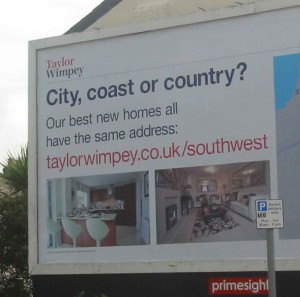
Placelessness haunts the streets of Truro in Cornwall. Source: Bernard Deacon’s website
• Placelessness is the term (which I may have coined – I’m not sure) I used when I wrote Place and Placelessness the 1970s. It refers to what I called the casual eradication of distinctive places and the deliberate making of standardized landscapes and the weakening of the identity of places to the point where they both look alike and offer the same bland possibilities for experience. It is less deliberate and more subtle than place destruction. Howard Kunstler’s The Geography of Nowhere is about the placelessness of suburban America.
• Nowhereness is a term used by M. Arefi (“Non-Place and Placelessness as narratives of loss” Journal of Urban Design Vol 4 No 2 1999, 179-193). He draws on Kunstler in his assessment of built environments with manufactured meaning and bleak sterility and a hodgepodge of contrived history and geography
• Homelessness. Heidegger’s claim in A Letter on Humanism is that: “Homelessness consists in the abandonment of beings by being…the symptom of oblivion of being.” If Heidegger is regarded as a pre-eminent philosopher of place, then placelessness can be regarded a particular manifestation of this ontological homelessness. Roberto Dainotto, in his 2000 book on Place in Literature suggests that: “the possibility of placelessness, offered for instance by modernity, remains for Heidegger a debasement of what ought to be authentic and rooted” and that it was the threat of placelessness (or more specifically unheimlichkeit – homelessness) that stimulated Heidegger’s fascination with place. Dainotto, incidentally, sees the greater threat as being place, and the rooted exclusionary attitudes associated with it.
• Unmaking of Place (or placeunmaking). This infrequently used term is, I think, invaluable as a caution about placemaking – best laid plans too often go awry. Jame Kalven, who spent many years working and placemaking in public housing projects in Chicago, uses it to describe the consequences of the Plan for Transformation in which the city demolished projects in order to make places supposedly better but which were, in his view, an assault on the identities of those for whom these doomed places were home. The transformation was, in a sense, the polar opposite of preservation and placemaking.
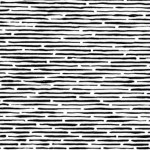
Webber’s diagram of the non-place urban realm. Geographical space extends horizontally and level of specialization vertically, so the top bars are global and the bottom bars are local. Individuals participate first in one realm and then another as they play first one role and then another.
• Non-Place Urban Realm was the term proposed by Melvin Webber in 1964 to suggest a new era in which accessibility has become more important that propinquity, in which place operates at many scales, some local and focused and others extended through behaviour and connections with relatives and colleagues across regions, continents, and around the world. (“The Urban Place and the Non-Place Urban Realm” pp.79-153 in M.Webber et al 1964 Exploration into Urban Structure, University of Pennsylvania Press).
• Non-Place is also used by the French anthropologist Marc Augé, but in a more specific sense to refer to a space that, in contrast to places in traditional cultures, is not relational, historical or concerned with identity. Non-places are products of supermodernity, such as clinics, hospitals, expressway service stations, and airports, where experiences are contractual because we have bought a ticket, are a driver, patient, customer etc. (Marc Augé, 1995 Non-Places: Introduction to the Anthropology of Supermodernity, London: Verso.)
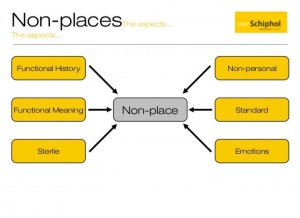
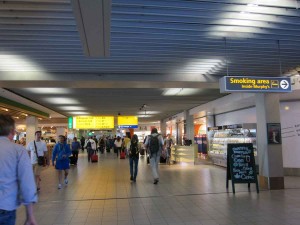 The image on the left is from a website discussing Schiphol airport in Amsterdam as a non-place. The photo on the right is my photo of Schiphol taken in 2014.
The image on the left is from a website discussing Schiphol airport in Amsterdam as a non-place. The photo on the right is my photo of Schiphol taken in 2014.
• Noplaceness – the title of an exhibition by Atlanta Art Now on “the feeling of not belonging anywhere, even when connected directly to a physical space.” The exhibition was “a manifesto for 21st century geographies” which are marked by the absence of distinct and historical place identity. “Geography has failed. The logic of globalization continues to throw into question an endless number of paradigms the 20th century taught us to love. Borders, stable identities and local languages all find themselves now under assault…All places threaten to become noplace in particular.” (Cullum, J., Fox, C., and Hicks, C., 2011 NoPlaceness: Art in a Post-Urban Landscape, Atlanta Art Now)
• Atopia is a word used by Massimo di Felice, a sociologist at the University of Sao Paulo, to comment about the Noplaceness show in Atlanta. Atopia is no longer tied to geographic coordinates or genius loci, but to information flows and a mutant spatiality. Paul Virilio (1997 Open Sky, Verso) uses atopia in the context of “teletopia,” by which he means our age of the speed of light in which we live with paradoxes such as meeting at a distance and remote interrelationships. Virilio’s idea has similarities to the non-place urban realm, but understood through the lens of electronic communication which was in the far background when Webber wrote in the 1960s.
 • Unplace is another term coined by artists (http://unplace.org/ Unplace: A Museum without a Place). The unplace project discusses the notion of “intangible museography” in which contemporary art exhibitions are specifically produced for virtual and networked contexts.
• Unplace is another term coined by artists (http://unplace.org/ Unplace: A Museum without a Place). The unplace project discusses the notion of “intangible museography” in which contemporary art exhibitions are specifically produced for virtual and networked contexts.
• Dystopia – the opposite of utopia, familiar in futuristic novel and movies, where the world and everywhere in it is a bad, violent, threatening, dispiriting, autocratic place.
• Polytopia means one space occupied by several different geographies contexts. It is a useful way to describe multi-ethnic, cosmopolitan cities. Anthropologist Clifford Geertz puts it this way: “We live more and more in an enormous collage, with the migration of cuisine, of peoples, furnishings, and it is difficult to know where to enter this “grand assemblage of juxtaposed difference.” (“The Uses of Diversity” Michigan Quarterly Review (25(1) 1986)
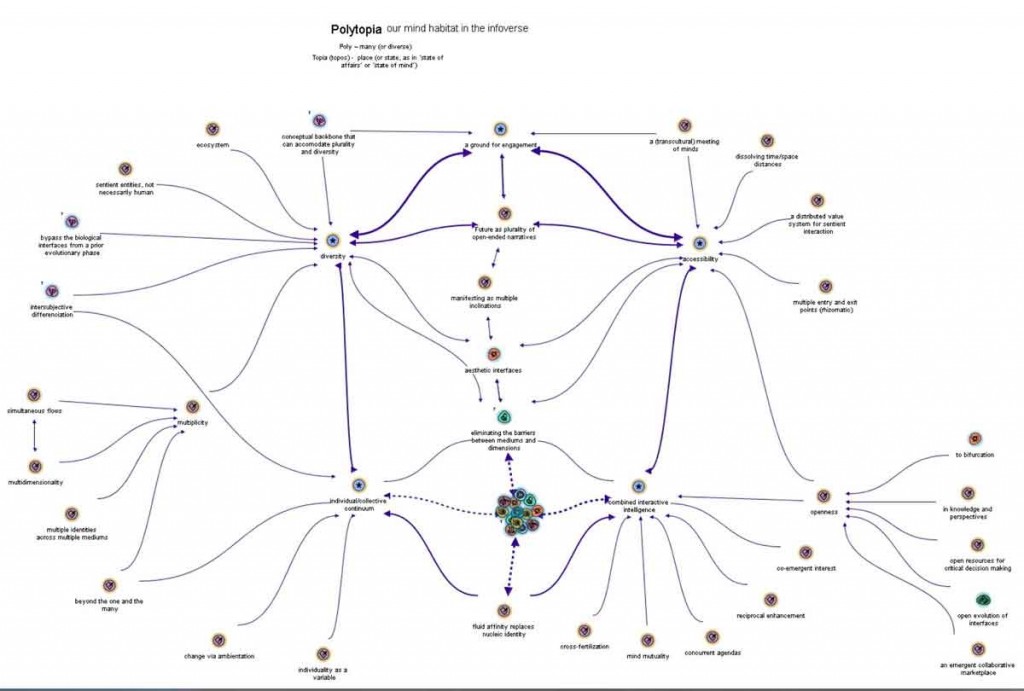
A image of polytopia at Metamaps. I am not sure I could understand it even if I could read the captions.
• Heterotopia strictly means something that is out of place, such as a cancerous growth. The concept was popularized by Michel Foucault who used it in The Order of Things to refer to polytopic situations in which “fragments of a large number of possible orders glitter separately, without law or geometry,” where things are laid, placed or arranged in sites so very different from one another that it is impossible to define a common locus beneath them all. “We are,” he wrote “in the epoch of simultaneity, we are in the epoch of juxtaposition, the epoch of the near and the far, of the side-by-side, of the dispersed” (“Of Other Spaces” Diacritics, Vol 16:1 1986, p.22). In other words, places lose their meanings because their contexts are unstable.
• Disembedding is the term used by sociologist Anthony Giddens (1990 The Consequences of Modernity, Stanford University Press) to refer to “the lifting out of social relations from local contexts and interactions and their restructuring across indefinite spans of time-space.” It is related both to transnationalism and the non-place urban realm.
• Displacement refers to forcible removal from a familiar place and it is the undoing (opposite of?) of place attachment. It is a specific and imposed form of disembedding. Marc Fried, author of a seminal study in the 1960s of the uprooting of a poor community in Boston, has written that forced displacement can be among the most severe psycho-social impacts an individual or community can suffer (“Continuities and Discontinuities of Place” Journal of Environmental Psychology, 20, 193-205).
• Rootshock is Mindy Fullilove’s neologism for the emotional impact caused to African-American communities by uprooting and displacement because of urban renewal. She argues that the place we call home is inscribed into our bodies, the street we call ours is the setting for our communal longing, and rootshock caused by urban renewal destroys the individual’s working model of the world, creates anxiety, and destroys social, emotional and financial resources. (2004 Rootshock: How Tearing Up City Neighborhoods Hurts America and What We Can Do About It, New York: Ballantine).
• Uprooting is an older and more widely used word for rootshock. Robert Coles wrote in Uprooted Children (1970, Harper and Row): “It is utterly part of our nature to want roots, to need roots, to struggle for roots, for a sense of belonging.” Uprooting is the disruption of this sense of belonging, whether for social, political or environmental reasons.
• Drudgery of Place. I wrote about this in Place and Placelessness (p.41) as the sense of being bound by routine and familiarity and what Henri Lefebvre called “the misery of everyday life.” It is not so much anti-place as a negative aspect of place experience. The sentiment is captured in the following lyrics by a group called The Postal Services, presumably from Seattle.
This place is a prison
And these people aren’t your friends
Inhaling thrills through $20 bills
And the tumblers are drained and then flooded again
And again.
Ther’re guards at the on-ramps armed to the teeth
And you may case the grounds from the Cascades to Puget Sound
But you are not permitted to leave.
• Deterritorialization is a term that comes from French philosophers Deleuze and Guattari (1987 A Thousand Plateaus; Capitalism and Schizophrenia University of Minnesota Press). It means the severance of social, political, or cultural practices from their native places and populations, and has relationships to uprooting, displacement and disembedding. However, they use the term in a more general sense of decontextualization or lifting out of context that can refer to mental illness or the practices of capitalism (the latter uses deterritorialization and repeated innovation as mechanisms of creative destruction to generate change). For Deleuze and Guattari deterritorialization is usually followed by reterritorialization and is part of process of continual transformation.
Former oppositions of place and placelessness have been transcended
Deleuze and Guattari’s discussion of deterriorialization and reterritorialization is a reminder that while the contrast between place and placelessness seemed a simple, binary opposition when I wrote about it in the 1970s, it has changed into something much more complicated.

An image by Fatemeh Aminpour of the Built Environment Programme at the University of New South Wales that captures the complex relationships of place, placeness and placelessness.
Indeed in 1984 Yi-fu Tuan (reference is below) wrote eloquently about a balance between roots and detachment from place: “We need to be rooted in place, for without roots we cannot develop those habits and routines that are essential components of sanity. We need to have a sense of place, because without it we shall have failed to use our unique capacity for appreciation. And finally, we need to be detached from place, because whether from a religious perspective or a clear-eyed humanistic one, place is necessarily a temporary abode, not an enduring city.”
Since then there have been mass migrations from less to more developed countries, electronic communications have come into widespread use, inexpensive air travel has allowed people to move rapidly and frequently around much of the world. This has been recognised, for instance, by Lucy Lippard in The Lure of the Local when she writes about the role of place in what she calls a multicentred society. Augé is careful to point out that non-place is not in opposition to place, but is tangled up with it: “In the concrete reality of today’s world, places and spaces , places and non-places intertwine and tangle together. The possibility of non-place is never absent from any place” (p.107). Giddens writes about re-embedding as well as disembedding. The non-place urban realm has been both reinforced and tempered by local and place-based communities that are the basis for social interaction, consumption and conflict that are nevertheless electronically and otherwise interconnected in many ways with other communities in far distant places.
The world in which we now live is filled with complex patterns of multicentred experiences and transnationalism that blend elements of place and placelessness in countless different ways. Processes that reinforce place and those that diminish it are tangled together and both can be celebrated. Place is where we feel we belong, non-place makes it convenient and easy to experience elsewhere and communicate with other communities in different places. We need both roots in places, and a clear-eyed detachment from places.
I hope to write more about multicentred place experiences and the intertwining of place and placelessness in future posts.
Tuan, Yi-Fu 1984 “In Place, Out of Place” in Place, Experience and Symbol, ed Miles Richardson, Geoscience and Man Series, Volume 24, Louisiana State University, Baton Rouge, pp. 3-10.